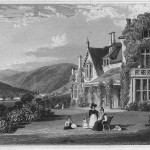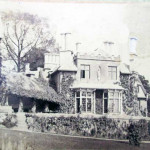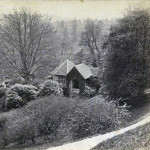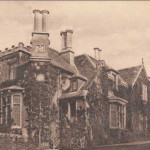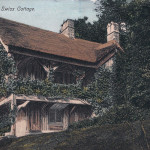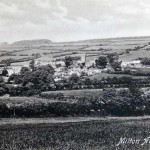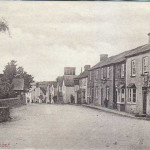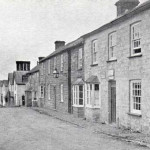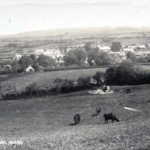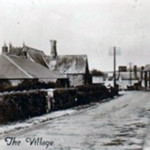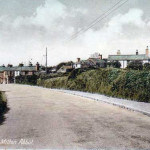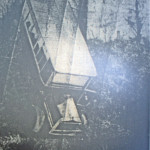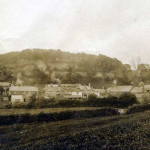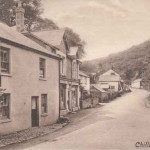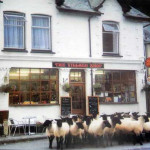.
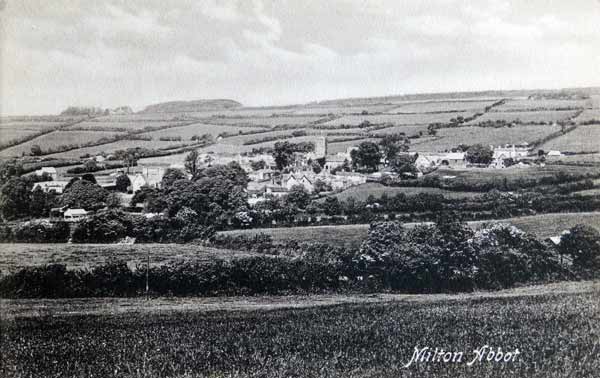
MILTON ABBOT, is approximately 1½ miles East of the river Tamar at Greystone Bridge, at the boundary with Cornwall, and 6¼ miles North West of Tavistock. Risdon, says that ” Milton Abbot did belong’ to the Abbey of Tavistock by the gift of a Knight that dwelt in Daversweek,” while Lysons tells us, ” This Manor was given to the Abbot and Convent of Tavistock, together with the Barton of Leigh, by Ordulph, its founder.” Both these statements are unsubstantiated by their authors. There is a discrepancy noticed by Dr. Oliver, in the description of the possessions of the Abbey of Tavistock at the period of the Domesday Survey given in both the Exchequer and Exeter copies of that record, but we learn from the latter that the Abbot held it under the name of Middeltona in the days of the Confessor, and that in 1087 it was still the property of Galfridus, the then head of the Benedictine community, whose Monastery, commenced by Ordgar, Earl of Devon, in the year 961, had afterwards been completed by his son Ordulph at a somewhat later date. By whatever means the Abbot and Convent became possessed of it, it is certain chat they held it through succeeding ages, until the dissolution ; and Bishop Bartholomew, of Exeter, shortly before his death, 1184, confirmed to Abbot Herbert, among other churches, that of Milton, which had been dedicated to S.S. Constantine and Giles.
At the Dissolution it passed to John, Lord Russell, as part of an enormous grant of the Tavistock lands, and still belongs to his lineal descendant, the Duke of Bedford. The estate has therefore changed hands only once in a thousand years.
During the early parts of the nineteenth century, huge deposits of copper were found in the Tamar valley south of Milton Abbot and for the next 150 years the whole area became heavily industrialised. The Dukes of Bedford profited hugely from these finds and passed on some of these profits through various community projects such as new housing and education. Manganese mines close to the village continued right up and through the second world war.
In 1810, with the profits gained from the mining, the then duke built a “cottage” at Endsleigh, over looking the wooded Tamar valley, from the designs of Sir Jeffry Wyattville. A statue of the last abbot of Tavistock thoughtfully decorates one of the ornmental gables of the cottage.
The house was built between 1810 and 1816 by John Russell, 6th Duke of Bedford as a private family residence, to the designs of Sir Jeffry Wyattville, in the style of the picturesque movement, and is a grand form of the cottage orné. It has been a Grade I Listed Building since 21 March 1967. It was situated within the manor of Milton Abbot, a former manor belonging to Tavistock Abbey, which had been granted with its lands by King Henry VIII to his ancestor John Russell, 1st Baron Russell (created in 1550 1st Earl of Bedford). It is situated on the east bank of the River Tamar, over which it commands superb views to the south and west. Pevsner stated that “the situation of Endsleigh can hardly be matched”. It was usefully positioned as a residence whilst the Duke, normally residing at Woburn Abbey in Bedfordshire, was inspecting his extensive Bedford estates in Devon and Cornwall. Before the Civil War, when in Devon the Earl of Bedford resided occasionally at Bedford House in Exeter, built by the family on the site of the Blackfriars Monastery, which had been granted, along with many other lands, to the first Earl of Bedford after the Dissolution of the Monasteries. Endsleigh was also used by the family as a summer holiday home and salmon-fishing lodge. The London streets Endsleigh Street, Endsleigh Gardens and Endsleigh Place, leading off Tavistock Square, all built by a former Duke on the extensive Bedford Estate are named after the family’s Devon property. Today Endsleigh is owned by Olga Polizzi and managed by her daughter Alex Polizzi.
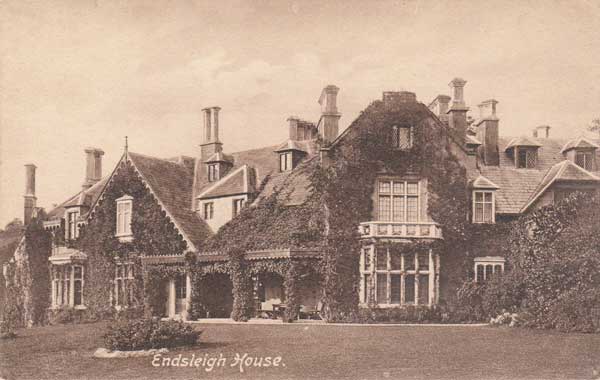
Not far from Endsleigh is the original nest of another great family-the Mount Edgecumbes. They were free-holders at Edgecumbe in the 13th century and the senior branch resided here until the 1840s. The present Edgecumbe House is mainly late medieval in date, but was refronted in 1719. In the 14th century, the de Cotehele family was one of Cornwall’s most powerful. Ralph and Hilaria de Cotehele, the orphaned children of this dynasty, were the wards of John, Earl of Cornwall, brother of the King, Edward III. In 1353, Hilaria, heiress to her brother’s estates, married William Edgcumbe and brought to the union her land at Cotehele. The Edgcumbes, her new husband William’s family, actually originated from Milton Abbot. In the 13th century, the family is recorded as living in the parish of Milton Abbot, where many buildings still bear the Edgcumbe name today. William Edgcumbe’s elder brother John, despite remaining in Milton Abbot, founded a second line of the family in Cornwall, with descendents based at Tregeare. Today Edgecumbe House is used as a farmhouse.
Leigh Barton was a Domesday manor.
The church (St. Constantine) falls within Tavistock Deanery for ecclesiastical purposes. It is a large structure which is mostly a 15th century building in the attractive green Hurdwick stone, with a tower and six bells. It is in the perpendicular style, and was refurbished in the 1840’s. It consists of a deep chancel, nave opening into a south aisle through an arcade of four bays, supported by third
pointed columns,—the arches, which are deeply moulded, are of a very debased character, a south porch, north door, and a handsome western tower, buttressed at the angles, embattled, and crow^ned by four pinnacles, with finials, but without crockets. The stairs leading to the belfiy are on the north side, and there are six bells. The edifice was restored in 1860; and there are several modern memorial windows, one in the south aisle to the memory of Maria, wife of John Jago, 1820. Dr. Jago was a former vicar.
The priest’s door on the south side opens into the large seat supplied with a fire place, which is apportioned to the Duke of Bedford. This door has a porch from about 1870, which has, unfortunately, blocked one of the windows of the aisle.
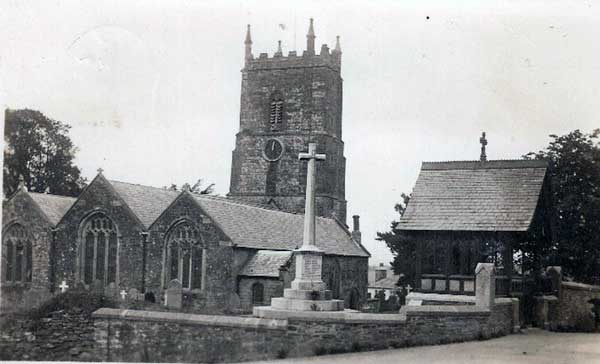
The octagonal Font is ornamented with quatrefoils, shields, and the cross quarterly. There are some good perpendicular bosses of foliage in the roof, and there is a fine circular tower-arch. The steps, which anciently led to the rood-loft, remain on the north side, and are contained in a turret. The entrance to the south porch is beneath a pointed arch, and the interior door also has one of similar character, with a
hood weather-moulding. The entrances beneath the tower and on the north side of the church have also arches of the same form. The ancient screen has been entirely removed. There are memorials for Robert A. A. Hammick, ob. 1861, aged 10 years, and for Sir Stephen Hammick, first Baronet, who died the 15th June, 1867, aged 90. There are, or were, also inscriptions for various members of the families of Edgcumbe and Doidge. Thomas Edgcumbe, 1589 ; Richard, 1642 ; Thomas, 1670 ; Richard, son of
Thomas, 1702 ; Thomas, son of Richard, 1725 ; Richard, son of Thomas, 1748 ; Thomas, his brother, 1763; Thomas, son of Thomas, 1777 ; Pierce (or Piers) Edgcumbe, AE994, 1731 (the last erected by his sons, Richard Edgcumbe, of Brompton, and Giles Edgcumbe, of Canterbury). Richard Doidge, of Leigh ob. 1584 ; Richard Doidge, 1661 ; Richard Doidge, 1717.
The Vicarage was built in 1838 and originally held eighty-seven acres of glebe. The registers of baptisms, marriages, and burials, commence alike, from 3rd December, 1635. The first deed relating to the parish land is dated 18th July, 1659, between Richard Doidge and others, feoffees, and David Hawkyns, lease of messuage, &c., in Tavistock for 90 years. 21st October, 1695. Grant by Richard Edgcumbe, John Tooker, and John Robins to Richard Doidge the younger, and others, tenement and garden in Tavistock, &c. Oliver Maynard is supposed to have been the donor. For the use, separation, and maintenance of the Parish Church.
In 1926, the Duke of Bedford had the Reading rooms and Village hall built on the site of the old Board School. The Milton Abbot Players regularly host productions in the village hall. They have produced a play since 1928, when Mary Kelly, with the support of the Vicar, started a pattern which has lasted for over seventy years. In the early years, the play was performed in the vicarage barn, above the stables. Later, when the Village Hall was built, the Duke of Bedford had a stage installed to provide a more theatrical event and often provided costumes for some of the more adventurous productions.
The parish also contains the hamlets of Chillaton, Edgcumbe, Foghanger, and Quither.
The Parish Expenditure Of Milton Abbot for 1588.
Milton Abbot Gallery.
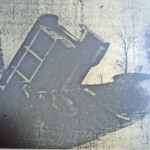
For more images of Milton Abbot’s past visit the Francis Frith Collection at www.francisfrith.com/milton-abbot and the Dartmoor Trust.

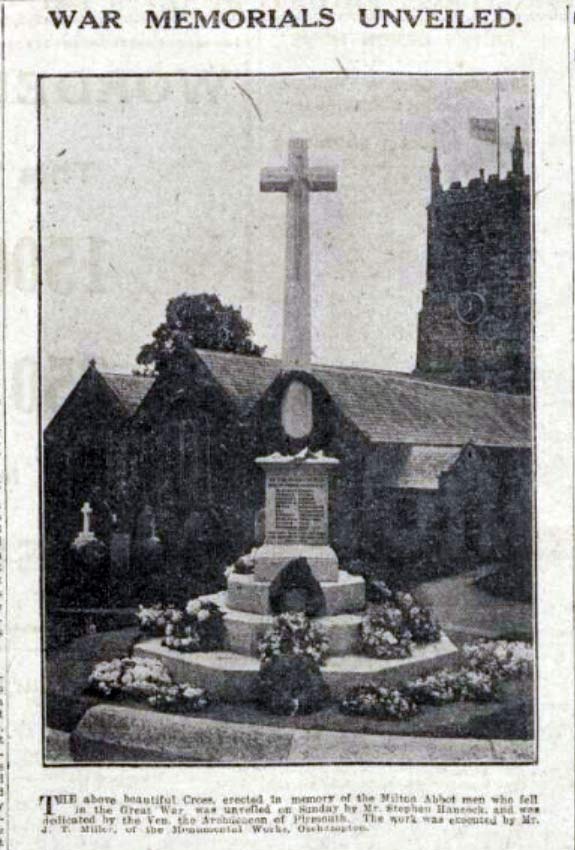
Milton Abbot’s Fallen from World War One
William Henry Dingle
William was born on July 25th, 1898, to Thomas and Elizabeth Dingle at Portington, Sydenham Damerel. His father worked as a mine labourer. He attended school at Milton Abbot. He enlisted with the Somerset Light Infantry (Regimental No. 28095) and was serving with the 1st Battalion when he was killed in action on August 22nd, 1918, aged 20.
Thomas Eggins
Thomas was born on December 11th, 1898, to William and Elizabeth Eggins at Park Farm, Milton Abbot. His father was a farmer but died when Thomas was just 2 years old. His mother later remarried a Mr. Marlow. He was initially a member of the Territorial 93rd Battalion (Service No. TR/7/6428) but enlisting at Plymouth with the Royal Fusiliers (City of London Regiment) (Regimental No. G/76107). He was serving with the 1st/4th Battalion when he was killed in action on August 23rd, 1918.
Charles Martin
Charles was born on February 18th, 1895 to Samuel and Mary Jane Martin at Kelly, Devon. His father was an agricultural labourer. The family were living at 2, Tuel Cottages, Sydenham Damerel in 1911. He was serving with the Royal Horse Artillery (Regimental No. 865589) Territorial Force when he died at Salonika on November 28th, 1917.
Montague Guy Pethick
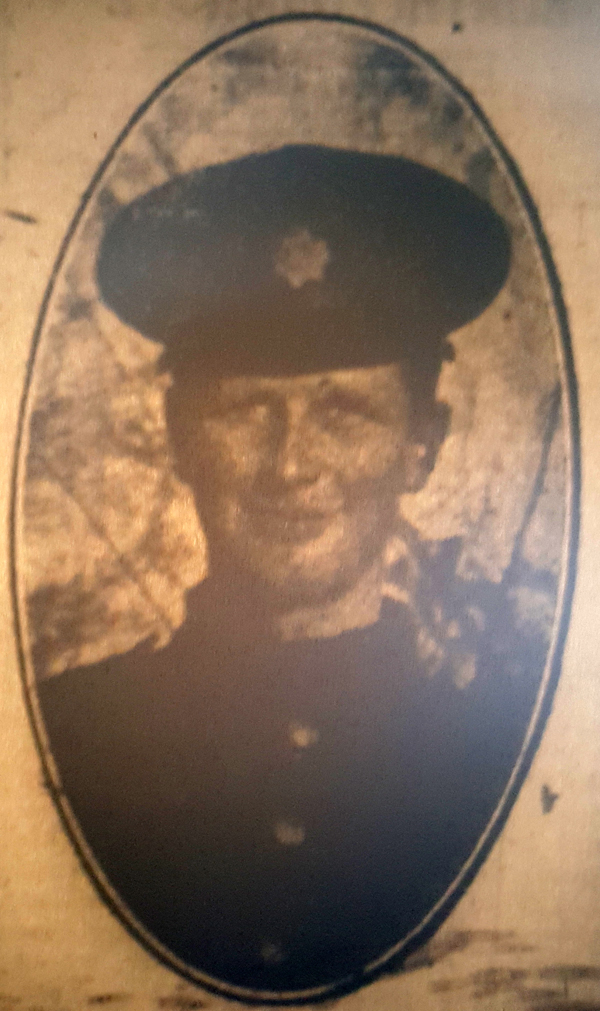
Montague or ‘Montie’ as he was known was born in 1898 to Richard and Amy Pethick at Egloskerry. He enlisted at Salisbury where he was in business, with the Devon Cyclists Corps. From Salisbury he was sent to Horlesley in Suffolk, for training and remained there until he was drafted to France in August, 1917, where he joined the Devonshire Regiment (Regimental No. 290785) as a Private with the 9th service Battalion. He was killed in action on October 26th, 1917 whilst fighting in France. His body was never identified but his name is commemorated on the Tyne Cot Cemetery, West-Vlaanderen, Belgium, Panel 38 to 40, and also on the Milton Abbot War Memorial. At the time of his death the family had moved to Milton Abbott.
Edwin Reddicliffe
Edwin was born in 1885 to William and Mary (nee Frise) Reddicliffe at Stowford. His father was a Manganese Miner. Mary, his mother died in 1887 when Edwin was just a little over two years old. He was serving with the Worcestershire Regiment (Regimental No. 202280) 1st/7th Battalion when he died of wounds presumably sustained in battle on November 18th 1917. He was interred at the Netley Military Cemetery, Hampshire.
Eri Wonnacott
Eri was born in 1895 to Eri and Elizabeth Wonnacot at Hardicott, Milton Abbot. His father was a farmer but died in 1899 when Eri junior was just 4 years old. Eri attended Tavistock Grammar school . He enlisted at Weston-Super-Mare with the Gloucestershire Regiment (Regimental No. 14813) serving with the 12th Battalion as a Lance Corporal. He died of his wounds sustained in battle on June 28th, 1918 aged 22.
Thomas Henry Wonnacott
Thomas was born on February 7th, 1897 to Eri and Elizabeth Wonnacott at Hardicott, Milton Abbot. A brother to Eri above, Thomas attended Milton Abbot school before going on to Tavistock Grammar School. He enlisted with the Devonshire Regiment (Regimental No. Unknown) as a Private, In November 1915, Thomas was made a Second Lieutenant on probation of the Members of the Inns of Court Officers Training Corps. He became a Second Lieutenant serving with the 3rd Battalion. It was whilst being attached to the 1st Battalion that Thomas was killed in action on May 9th, 1917 aged 20.
Hedley John Woolway
Hedley was born on July 8th, 1891 to John and Elizabeth Woolway at Cullompton, Devon. He went to school at Milton Abbot. On March 22nd, 1911 he emigrated to Canada aboard the ‘Royal George.’ He worked as a farm labourer once in Canada, He enlisted with the 43rd Battalion of the Canadian Regiment (Regimental No. 622605) (Manitoba Regiment). He was killed in action on August 12th, 1916 aged 25. He was interred at the Zantvoorde British Cemetery, Belgium.
George Yole
George was born on October 9th, 1882 to Matthew and Ann Yole at Milton Abbot. His father was a farm labourer. He attended Milton Abbot school and on leaving he went to work as a carter on a farm. By 1911 he was working as an odd job man at Endsleigh estate. He then moved to Woburn Abbey in 1912 and it is here that he enlists with the Queen’s (Royal West Surrey) Regiment (Regimental No. T/207035) as a Private. He was serving with the 11th Battalion when he was killed in action on August 1st, 1918 aged 35.
Frederick Yole
Frederick or Fred as he was known, was born on April 1st, 1893 to Matthew and Ann Yole. He was the brother to George above. Fred attended Milton Abbot school and on leaving school, he went to work for Mrs. Blanchard of Leigh Farm, Milton Abbot as a cowman. On March 30th, 1912 he emigrated aboard the ‘Megantic.’ At the outbreak of war he enlisted with the 78th Battalion, Canadian Infantry (Manitoba Regiment) (Regimental No. 148536). He was killed in action at the battle of ‘Vimy Ridge’ on April 9th, 1917 aged 24. His body was never identified but his name is commemorated on the Vimy Memorial.
Milton Abbot’s Fallen from World War Two
George Henry Cockwill
George was born in 1921 to George and Rosa (nee Whiting) Cockwill at Okehampton. The family moved to live at Kelly. He joined the Royal Navy (Service No. D/JX 154346) and served aboard the ‘HM Submarine Pandora’ as a leading seaman. The Pandora was bombed April 1st, 1942 at Hamilton Wharf, Valetta dockyard, Malta by Italian aircraft and George was killed. There were a few survivors of this incident but they lost their lives on another submarine which was mined on its way back to England a few days later.
Visits: 763

